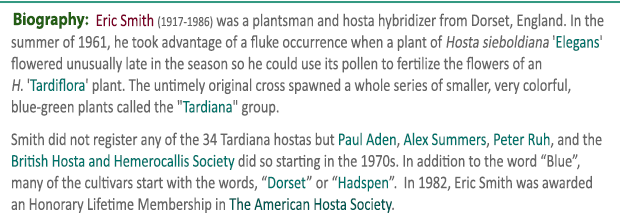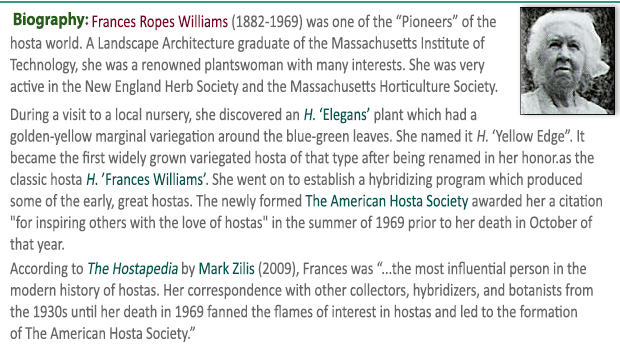|
 Hosta ‘Elegans’
is THE classic giant size blue hosta. It was originally
described as a cross between 'Fortunei'
×
H. 'Sieboldiana'
but, according to
The Hostapedia by Mark Zilis (2009), it is "...most likely a cross of
H. 'Sieboldiana'
× 'Tokudama'."
It was first introduced
for sale in Germany by
Georg Ahrends
in 1905 and
The American Hosta Society registered the cultivar
on his behalf in 1987 and again in 2002.
Mark Zilis
has called 'Elegans' the #1 hosta introduction of
all time. Hosta ‘Elegans’
is THE classic giant size blue hosta. It was originally
described as a cross between 'Fortunei'
×
H. 'Sieboldiana'
but, according to
The Hostapedia by Mark Zilis (2009), it is "...most likely a cross of
H. 'Sieboldiana'
× 'Tokudama'."
It was first introduced
for sale in Germany by
Georg Ahrends
in 1905 and
The American Hosta Society registered the cultivar
on his behalf in 1987 and again in 2002.
Mark Zilis
has called 'Elegans' the #1 hosta introduction of
all time.
'Elegans' forms a giant size (28 inches high
by 61 inches wide) mound of heavily
corrugated, slightly wavy foliage with a deeply lobed base and a
distinct tip. It produces funnel shaped, near white flowers in
dense clusters from mid-June into July.
According to
The Hostapedia by Mark Zilis (2009), "When
Georg Ahrends introduced his
Funkia fortunei var. robusta, I'm sure that he did not realize the impact that
this hybrid would eventually have. In essence,
H. 'Elegans' introduced thick substance and blue-green foliage
color to the hosta world. Almost any hosta with these
characteristics hearkens back to
H. 'Elegans'.
...H. 'Elegans' also has the distinction of
being a cultivar, but not a clone. This is rare among hosta
cultivars. The reason for this is its sluggish growth rate,
making propagation by division a slow task...nurserymen eager to
increase their stocks...germinated copious numbers of seeds.
Thus, the plants sold as
H. 'Elegans' today
are far removed from the original 'Elegans' and are not
identical to each other."
This cultivar has been awarded
the Royal Horticultural Society's Award of Garden Merit in the
UK.
 From the
Field Guide to Hostas by
Mark Zilis (2014), "...remains the standard to which all other large,
blue-green hostas are compared...Over the last 30
years, slight differences between 'Elegans'
seedlings resulted in several new introductions with
heavily corrugated, blue-green foliage. 'Gray
Cole' and 'Ryan's
Big One' probably come closest to the original 'Elegans',
but they are significantly different from other 'Elegans'-types
such as 'Blue
Mammoth' and 'Big
Daddy'." From the
Field Guide to Hostas by
Mark Zilis (2014), "...remains the standard to which all other large,
blue-green hostas are compared...Over the last 30
years, slight differences between 'Elegans'
seedlings resulted in several new introductions with
heavily corrugated, blue-green foliage. 'Gray
Cole' and 'Ryan's
Big One' probably come closest to the original 'Elegans',
but they are significantly different from other 'Elegans'-types
such as 'Blue
Mammoth' and 'Big
Daddy'."
 The New Encyclopedia of Hostas by
Diana
Grenfell (2009) states: "Over the years this name has been applied to a
variety of
H. 'Sieboldiana' selections and it is
likely that none of the plants in
tissue culture under this name is the correct plant, which may now
only be found in older collections and is likely to
be superior in leaf color and shape...Flowers are
bunched at the top of the scape, which rises only
just above the foliage mound." The New Encyclopedia of Hostas by
Diana
Grenfell (2009) states: "Over the years this name has been applied to a
variety of
H. 'Sieboldiana' selections and it is
likely that none of the plants in
tissue culture under this name is the correct plant, which may now
only be found in older collections and is likely to
be superior in leaf color and shape...Flowers are
bunched at the top of the scape, which rises only
just above the foliage mound."
At a recent winter Hosta Scientific
Meeting near Chicago, the
Hosta Registrar mentioned that of the
300 or so new cultivars registered the previous year, over half
of them had H. 'Elegans' in their background.
As you can see by the list below, there are a lot of big
blue-green hostas out there from which to choose. (Some might
say waaaay too many!)
'Elegans' may have
been sold at one time under the name Mackwoods No.
2.
Schmid (1991)
stated "...The name
H.
fortunei 'Robusta' was used by
Georg Ahrends in 1905 for the plant that eventually became
H. 'Elegans'..."

The
Hosta Journal, (2006 Vol. 37 No. 2), contained an
article in which several
hostaphiles were asked to give a brief list of
their
favorite hosta flowers. This plant was included
in that list.
 An article by W. George Schmid in
The
Hosta Journal (1985 Vol. 16) discusses the
University of Munich's trial gardens Staudensichtungsgarten Weihenstephan, "...a
fine collection of hostas. These are of great importance from a historical
standpoint, because many of the cultivars there came from the early German
hybridizers, including:
H. sieboldii (syn. H. albomarginata) 'Alba Improved',
H. ventricosa 'Superba', H. tardiflora 'Hybrids'
and H. 'Elegans'." An article by W. George Schmid in
The
Hosta Journal (1985 Vol. 16) discusses the
University of Munich's trial gardens Staudensichtungsgarten Weihenstephan, "...a
fine collection of hostas. These are of great importance from a historical
standpoint, because many of the cultivars there came from the early German
hybridizers, including:
H. sieboldii (syn. H. albomarginata) 'Alba Improved',
H. ventricosa 'Superba', H. tardiflora 'Hybrids'
and H. 'Elegans'."
Alex
Summers in
The
Hosta Journal (1995 Vol. 26 No. 2) states that, "H.
'Frances Williams' was registered...without detailed description or photos...the
plant was discovered in 1936 by Mrs. Frances Williams...in rows of H. 'Elegans'
at Bristol Nurseries in Bristol, Connecticut...Frances
Williams sent a division to the
University Botanic Garden in Oxford,
England in
1959. It was named by George Robinson at a Royal Horticultural Society lecture
on variegated plants."
In
The
Hosta Journal (1996 Vol. 27 No. 2) Warren I. Pollock states that, "H. 'Blue
Angel' is one of the best large blue-leaved hostas. The leaves are more pointed
and less seersuckered than those of H. 'Elegans'
. I happen to think
the leaves are a good blue color; there are other big hostas with bluer
leaves...it is a faster grower than H. 'Elegans'
...an exciting new
sport of 'Blue Angel'. ..H. 'Guardian Angel' is a blue-leaved hosta with an
attractive, wide center variegation....Not surprisingly, 'Green Angel' is the
green sport."
Pollock continues in
The
Hosta Journal (1997 Vol. 28 No. 1) writing, "There
already is a blue hosta with the leaf curling character of 'Stetson'. It is a
seedling of
H. 'Sieboldiana' (not H. 'Elegans'
) with pollen parent
unknown. The leaf blades are canoe shaped, even more curled on the sides than
'Stetson'. Its very fitting name is 'Blue Canoe'...an exciting new introduction
of Gwen Black who gardens in...England."
An article about H. 'Great Expectations' by Warren I. Pollock in
The
Hosta Journal (2000 Vol. 31 No. 1) reports that
John
Bond wrote, "I became aware of an obvious sport on a substantial clump of
H. 'Elegans'
...in the rhododendron species collection in the Valley
Gardens in Windsor Great Park during the early 1980s. After a year or so I
decided to remove this sport for it was clearly promising to say the least...The
three "cuttings" were carefully planted in a sheltered corner of my own
garden...The following spring produced three nice little plants...Rightly or
wrongly I gave Paul Aden [Baldwin, New York] one of my plants and the remaining
two were transferred to the
Savill Garden from where sadly they were both
stolen!...So that is the very simple story and explains that there was no
mysterious breeding programme and also that H. 'Frances Williams' had no part to
play."
 In
The
Hosta Journal (2001 Vol. 32 No. 1),
Tom Micheletti,
former President of The American Hosta Society took on the task of listing the
"Classic Hosta Cultivars" through the year 2003. He decided to divide these into
categories including: Green,
Blue,
Yellow (Gold,
White-Margined,
Yellow-Margined,
White Medio-Variegated
and Yellow
Medio-Variegated. He writes that "No other genus in the plant kingdom has
as many blue-leaved variants...Grandaddy of the blues would be H. 'Elegans'. H. 'Tokudama' would be the other parent that
has passed along the blue leaf characteristics." In
The
Hosta Journal (2001 Vol. 32 No. 1),
Tom Micheletti,
former President of The American Hosta Society took on the task of listing the
"Classic Hosta Cultivars" through the year 2003. He decided to divide these into
categories including: Green,
Blue,
Yellow (Gold,
White-Margined,
Yellow-Margined,
White Medio-Variegated
and Yellow
Medio-Variegated. He writes that "No other genus in the plant kingdom has
as many blue-leaved variants...Grandaddy of the blues would be H. 'Elegans'. H. 'Tokudama' would be the other parent that
has passed along the blue leaf characteristics."
An article about the Halcyon Group
written by
Peter Cross in
The
Hosta Journal (2004 Vol. 35 No.2) says, "Though
'Halcyon' is not the bluest hosta now available, no blue hosta has yet to match
the balance of color, size, habit and growth rate that has made 'Halcyon' the
classic medium-sized blue hosta...One simply doesn't have a hosta collection
until it contains at least one clump of 'Halcyon'. ..is a first-generation member
(TF 1 × 7) of the legendary Tardiana Group of hostas, which consists of hybrids
of 'Tardiflora' × H. 'Elegans', produced in
England by
Eric Smith,
the master hybridizer of blue hostas, in the 1960s."


| |
|
 An article by
Warren I. Pollack in
The
Hosta Journal (2020 Vol. 51 No. 1) titled
Doppelgänger Hostas: Fancy Name for
Look-alike Hostas, included a long list of hostas
which various hostaphiles, published articles or other sources have
indicated "look" the same. Some of these are, in fact, the same
plant with two or more different names. Others are hostas that vary
in some minor trait which is not immediately discernable to the
casual observer such as seasonal color variations, bloom traits, ploidy, etc. So, as Warren mentions, hostaphiles may differ as to the
plants listed but then, their opinions are based on visual observations and interpretations. An article by
Warren I. Pollack in
The
Hosta Journal (2020 Vol. 51 No. 1) titled
Doppelgänger Hostas: Fancy Name for
Look-alike Hostas, included a long list of hostas
which various hostaphiles, published articles or other sources have
indicated "look" the same. Some of these are, in fact, the same
plant with two or more different names. Others are hostas that vary
in some minor trait which is not immediately discernable to the
casual observer such as seasonal color variations, bloom traits, ploidy, etc. So, as Warren mentions, hostaphiles may differ as to the
plants listed but then, their opinions are based on visual observations and interpretations. |
| |
 H.
'Elegans', H. 'Gray
Cole' and
H. 'Ryan's
Big One'. H.
'Elegans', H. 'Gray
Cole' and
H. 'Ryan's
Big One'. |
|
|
















 |



